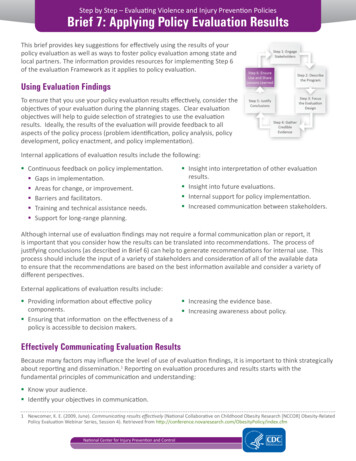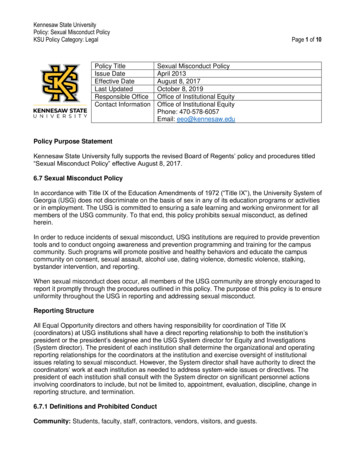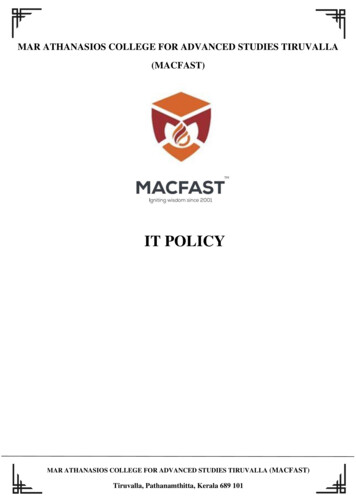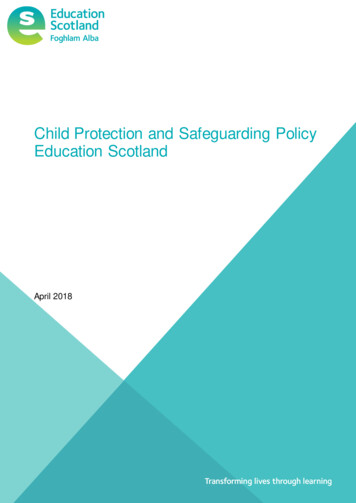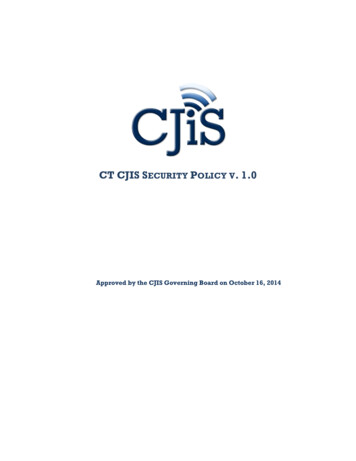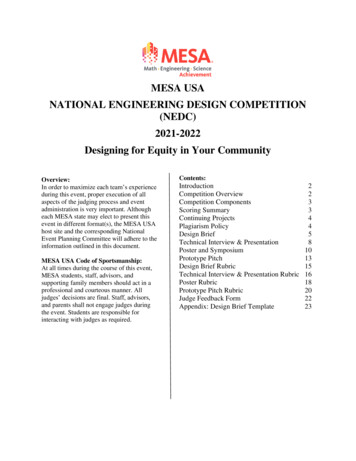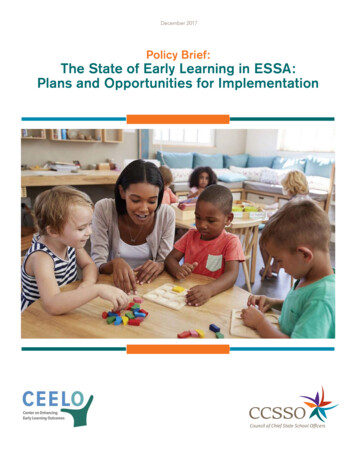
Transcription
December 2017Policy Brief:The State of Early Learning in ESSA:Plans and Opportunities for Implementation
Center on Enhancing Early Learning OutcomesThe Council of Chief State School OfficersOne of 22 Comprehensive Centers funded bythe U.S. Department of Education’s Office ofElementary and Secondary Education, the Centeron Enhancing Early Learning Outcomes (CEELO)will strengthen the capacity of State EducationAgencies (SEAs) to lead sustained improvementsin early learning opportunities and outcomes.CEELO works in partnership with SEAs, state andlocal early childhood leaders, and other federaland national technical assistance (TA) providersto promote innovation and accountability.The Council of Chief State School Officers (CCSSO)is a nonpartisan, nationwide, nonprofit organizationof public officials who head departments ofelementary and secondary education in the states,the District of Columbia, the Department ofDefense Education Activity, and five U.S. extra-statejurisdictions. CCSSO provides leadership, advocacy,and technical assistance on major educationalissues. The Council seeks member consensus onmajor educational issues and expresses their viewsto civic and professional organizations, federalagencies, Congress, and the public.www.ceelo.orgwww.ccsso.orgPolicy Brief: The State of Early Learning in ESSA: Plans and Opportunities for ImplementationSuggested Citation: Center on Enhancing Early Learning Outcomes (CEELO) and the Council of Chief State School Officers (CCSSO). 2017.Policy Brief: The State of Early Learning in ESSA: Plans and Opportunities for ImplementationRetrieved from: http://ceelo.org/wp-content/uploads/2017/12/ceelo ccsso policy brief essa ece.pdfProject Directors: Rolf Grafwallner and Lori Connors-TadrosCEELOSteven Barnett, Ph.D., Principal InvestigatorLori Connors Tadros, Ph.D., Senior Project DirectorNational Institute for Early Education ResearchRutgers, The State University of New Jersey73 Easton Avenue New Brunswick, NJ 08901-1879 www.ceelo.orgCOUNCIL OF CHIEF STATE SCHOOL OFFICERSCarey Wright (Mississippi), State Superintendent and CCSSO Board PresidentCarissa Moffat Miller, Acting Executive DirectorOne Massachusetts Avenue, NW, Suite 700 Washington, DC 20001-1431Phone (202) 336-7000 Fax (202) 408-8072 www.ccsso.org 2017 by CEELO and CCSSO. Policy Brief: The State of Early Learning in ESSA: Plans and Opportunities for Implementationis licensed under a Creative Commons Attribution 4.0 International License https://creativecommons.org/licenses/by/4.0/.Photo credits: iStock.com
AcknowledgementsThis policy brief was written by Bonnie O’Keefe, Senior Analyst, Bellwether Education Partners for the Center on EnhancingEarly Learning Outcomes and the Council of Chief State School Officers.We thank the following individuals for their thoughtful reviews of earlier versions of the brief.Danielle Ewen, EducationCounsel LLCElliot Regenstein, Ounce of Prevention FundAlbert Wat, Alliance for Early SuccessCEELO greatly appreciates the financial support from The Alliance for Early Success and The Council of Chief State SchoolOfficers as a collaborating partner of CEELO.
ContentsIntroduction. 2Early Learning in State ESSA Plans. 4Setting clear goals and policy priorities for early learning. 4Integrating early learning into school improvement . 6Supporting early childhood educator development .10Next Steps and Further Opportunities.12Appendix A: Methodology.13Appendix B: State Plan Summaries. .14Policy Brief: The State of Early Learning in ESSA: Plans and Opportunities for Implementation1
IntroductionThe Every Student Succeeds Act (ESSA), which was signed into law late in 2015, givesstate education agencies (SEAs) the opportunity to bring early learning to the forefront oftheir education strategies. The early years in a child’s life form the foundation for futurelearning and development. Access to high-quality educational opportunities during theearly years can prevent achievement gaps and yield short-term and long-term benefits forstudents. ESSA greatly increases state flexibility around school accountability andimprovement strategies. In so doing, it providesopportunities for SEAs to integrate early learning into theirlong-term goals, school improvement systems, andeducator professional development efforts.All SEAs have submitted their ESSA plans to the U.S.Department of Education (ED). ESSA plans are animportant milestone for SEAs in their ongoing work toaddress educational inequities, raise performance, andPolicy Brief: The State of Early Learning in ESSA: Plans and Opportunities for Implementationclose achievement gaps, in early learning and beyond.2The plans provide a window into some promising andinnovative approaches to early learning, including thoseimpacting children with disabilities and Head Start, whichWhat do we mean by“early learning”?State education agencies havevarying levels of oversightfor programs serving childrenunder kindergarten age. In thecontext of state ESSA plans,very few SEAs address earlylearning before pre-K. Thus,most proposals covered in thisSEAs must now translate into implementation.brief focus on pre-K to thirdBuilding early learning in these policy areas is new forearly childhood educationmost SEAs, and state education leaders—including chiefs,before children reach pre-Kaccountability directors, and early learning directors—is still extremely relevantwanted additional guidance and assistance as theyto SEAs’ goals. In the longmove forward. In response, the Council of Chief Stateterm, SEAs should aim for anSchool Officers (CCSSO) and the Center on Enhancingaligned birth through thirdEarly Learning Outcomes (CEELO) created a number ofgrade approach that includesresources for SEAs, including a Birth to Grade 3 Indicatorpre-K, Head Start, Early HeadFramework, a guide to state leadership opportunities,Start, child care providers, andwebinars for state leaders, and a blog series on ESSA andelementary schools.grade. Access to high-qualityearly learning.All SEAs mentioned early learning or school readiness in their state plans in some way,though each SEA put more or less emphasis on intentional strategies to integrate earlylearning in their plan. This is a sign that SEAs understand the importance of earthierESSA plans thus far. We hope the examples in this brief will encourage SEAs to expandtheir commitment to early learning as a key strategy for closing achievement gaps andimproving educational outcomes. Today’s state plans will form the backbone of ESSAimplementation, but these plans are just the beginning of SEAs’ work. This means sharing
ideas and best practices among SEAs will be an ongoing project. Some SEAs havealready issued implementation guidance to build upon their plans and several SEAs mayphase-in new quality indicators in future years.This brief reviews state plans submitted to the U.S. Department of Education as of October1, 2017. It focuses on three key topics for early learning in ESSA: setting clear goals andpolicy priorities for early learning, integrating early learning into school improvement, andsupporting early childhood educator development.1 Each of these topics has significantpotential for impact on early learning if implemented well at the local level:1. Setting clear goals and policy priorities for early learning: Improvingaccess to high-quality early learning from birth to third grade is linked toimproved outcomes for students. Achieving these outcomes requires cleargoals, sustained commitment, and strategic action across multiple agencies,stakeholders, and leaders at every level of education. ESSA plans can supportand communicate a state’s goals and priorities around early learning, andensure that the early grades are a central priority in multiple parts of a state’seducational improvement strategies. Does the state plan include improving early learning as a state goal or Is early learning embedded in multiple sections of the state plan in a waythat demonstrates the state’s goals, policy agenda, and priorities aroundearly learning?2. Integrating early learning into school improvement: If early learning is a key partof elementary school improvement strategies, schools will be more likely to succeedat closing gaps and raising performance early, before students need extensiveremediation. ESSA is a key lever for integrating early learning strategies into schoolimprovement plans, because state ESSA plans set out proposals for identifying andsupporting low-performing schools. Does the state propose to use indicators that include students underthird grade as part of its school quality rating and improvement effortsunder ESSA? Does the state address any of the four key school improvementopportunities—school quality ratings, interventions and supports for lowperforming schools, transparency and public reporting, and/or school districtaccountability and improvement, as described in the Birth to Third GradeIndicator Framework?We acknowledge that there are other important areas that impact effective early learning that are notmentioned in this brief, such as coordination, transition activities, and support for special populations. Weintend to address these topics as we learn more about implementation of ESSA plans.1Policy Brief: The State of Early Learning in ESSA: Plans and Opportunities for Implementationkey strategy?3
3. Supporting early childhood educator development: Quality teaching is the topin-school factor in students’ success. This is especially important in pre-K to thirdgrade, as students build the foundation of knowledge and skills that will supportthem in the future. Teachers and principals should have support and professionaldevelopment opportunities to deliver high-quality learning experiences for youngchildren.i Developing the educator workforce for children ages birth through eightis a challenge all SEAs must work to address. Does the plan include targeted professional development opportunities forteachers of young children, from birth through third-grade? Does the plan include specialized training or support for principals and/or other building leaders on child development, school readiness and earlylearning instruction and practice?The examples below are not fully exhaustive, but are meant to highlight a variety ofapproaches from different SEAs, and identify areas for further growth and attention asSEAs shift their focus to implementation. It is also important to note that the format ofthe state plan templates may be a limiting factor, and the required elements of the plansPolicy Brief: The State of Early Learning in ESSA: Plans and Opportunities for Implementationmay not reflect the breadth of SEAs’ work around early learning. See Appendix A for4a summary of the methodology used to review plans, and Appendix B for a high levelsummary of how and where each state plan addresses early learning.Early Learning in State ESSA PlansSetting clear goals and policy priorities for early learningA state plan that includes clear goals and policy priorities around early learningcommunicates a strong message to schools and other stakeholders: this state valueschildren’s success from the start. ESSA clearly acknowledges the importance of earlylearning throughout the law,however there are very fewrequirements to address earlylearning in the SEA’s ESSA plan.Importantly, many SEAs includedearly learning improvement aspart of their long-term goals andstate strategies. These SEAs areA state plan that includes cleargoals and policy priorities aroundearly learning communicates astrong message to schools andother stakeholders: this state valueschildren’s success from the start.noted in Appendix B.The widespread inclusion of early learning in state priorities demonstrates a promisingand important commitment to early learning. A few SEAs went even further by integrating
early learning as a top policy priority throughout the SEAs’ plans. These SEAs will enter theimplementation phase of ESSA with a strong framework to broaden and deepen their workon early learning.Delaware, New Mexico, Oklahoma and Tennessee are selected examples of SEAs thatdemonstrated clear goals around early learning, including an emphasis on early learning inmultiple parts of their ESSA plans. Delaware put “high-quality early learning opportunities” front and center as oneof the state’s top five priorities. The state’s ESSA plan links with the DelawareEarly Learning Council Strategic Plan, which set goals around health, high-qualityearly learning programs, aligned birth through third grade systems, and sustainedimprovement. The state also:oo Identifies multiple federal funding streams to support goals.oo Offers technical assistance around early learning for schools.oo Offers targeted professional development for early educators.oo Focuses on curriculum and assessment alignment between early learningoo Requires local districts to report expanded data for state report cards onearly learning indicators, including early learning programs in close proximityto local districts in state report cards. New Mexico emphasizes early learning in its state ESSA plan and SEA strategicplan. The state highlights goals for increasing kindergarten readiness and closingopportunity gaps for young children. It also places an emphasis on early elementaryschool as an opportunity to narrow achievement gaps, with kindergarten throughsecond grade diagnostic and screening measures, and after school and extendedlearning opportunities. In the ESSA plan, the state:oo Offers a comprehensive array of technical assistance strategies for schoolsrelated to early learning.oo Uses multiple data tools to track and improve early performance, includingclassroom observations and early literacy assessments.oo Includes K-3 students in multiple parts of school quality ratings, includingfuture plans for school climate surveys.oo Plans to develop an open-source K-6 reading curriculum Oklahoma a national leader in early childhood education for nearly two decades,has included an ambitious goal for kindergarten readiness in its state ESSA planPolicy Brief: The State of Early Learning in ESSA: Plans and Opportunities for Implementationprograms and K-12.5
and 8-Year Strategic Plan. By aligning early childhood education and learningfoundations to ensure at least 75 percent of students are “ready to read” bykindergarten, the state is emphasizing the critical partnership between familiesand early childhood teachers to achieve education readiness and, ultimately,success. The ESSA plan includes:oo A “start early” equity trait emphasizing the importance of investing in theyoungest learners.oo Longitudinal data to document the effects of universal Pre-K on allstudent groups.oo Strong and diverse public-private partnerships to support coordination ofearly childhood providers and expand mixed delivery of PreK in assistedliving centers, tribal early childhood centers, universities, and others.oo Oklahoma Academic Standards vertically aligned beginning in Pre-K.oo Rich professional development opportunities for early education teachersPolicy Brief: The State of Early Learning in ESSA: Plans and Opportunities for Implementationand early learning-focused PD for administrators.6oo A pathway for early learning paraprofessionals to become lead teachers. Tennessee showed a strong commitment to early learning in their state plan,which is one of their top five statewide focus areas. The state also supports earlylearning in the organizational structure of the SEA. In the ESSA plan, the state:oo Offers targeted professional development for pre-K to third grade educators.oo Created comprehensive assessment and data tools for early grades.oo Includes early learning as a school improvement strategy.oo Emphasizes early learning in state funded research.These multi-pronged approaches are promising because they set the stage forongoing commitments to early learning throughout a state’s work under ESSA. It showsstakeholders that the state sees early learning as a critical piece of student successacross different policy areas.Integrating early learning into school improvementSchool improvement strategies make up a large part of state ESSA plans. Key elementsinclude how SEAs will identify low-performing schools, support schools to improveachievement of students, and report cards on school results. Improving access tohigh-quality learning opportunities in pre-K to third grade (and earlier) can closeachievement gaps early and put students on a trajectory to greater success. Some SEAs
described early learning strategies to drive improvement in low-performing schools,and expanded reporting and data sharing around early learning.The first school improvement opportunity is around school quality ratings, whichdetermine which schools are subject to improvement processes. ESSA requires SEAsto identify at least one indicator of “school quality or student success,”ii which couldinclude early grades. Including early grades in one or more elements of these ratingsemphasizes that early learning is an indispensable component of school quality, andencourages schools to prioritize pre-K to third grade results.A common school quality indicator included in SEA’s ESSA plans is chronicabsenteeism. 2 Over 30 SEAs chose some measure of chronic absenteeism as acomponent of their school qualityratings. iii SEAs that included earlyabsenteeism align with research showingthat absenteeism rates are quite high inearly grades, and that children who arechronically absent in kindergartenperform worse in later grades.Absenteeism can be an earlywarning indicator for lateracademic problems anddropping out, and a contributorto academic achievement gaps.Absenteeism can be an early warningacademic achievement gaps.Almost all these SEAs will measure chronic absenteeism starting from kindergarten,though a few states will begin in PreK. For example, Rhode Island has proposed a“Chronic Absenteeism Indicator” that will examine the percentage of teachers andstudents who are chronically absent in grades PreK-twelve. Illinois is consideringweighting chronic absence in kindergarten through grade 2, to stop any snowballing ofpatterns of chronic absence that are often begun early in student’s school experienceand have much more significant consequences.ivA few other SEAs will use school climate surveys, while more plan to research thesemeasures and phase them in over time. These surveys capture multiple non-academicdimensions of the school environment, such as discipline, student engagement, andschool culture. It was not always clear in state plans whether these survey tools willinclude students, parents, and teachers in early grades, but most begin surveyingstudents in fourth or fifth grade. Appropriate, high-quality survey tools for youngerstudents could be a valuable tool to bring cross-grade coherence and alignment toschool culture initiatives in elementary schools. Colorado and New Mexico are amongthe SEAs investigating these kinds of surveys for younger grades.Chronic absenteeism is usually defined as the percentage of students out of school for more than 10percent of the school year.2Policy Brief: The State of Early Learning in ESSA: Plans and Opportunities for Implementationindicator for later academic problems and dropping out, and a contributor to7
SEAs with other proposals for incorporating early learning in their school qualityratings include: The District of Columbia will include scores from the pre-K ClassroomAssessment Scoring System (CLASS) in its elementary school ratings. CLASSmeasures teacher-student interactions across three domains: instructionalsupport, emotional support, and classroom environment. Ohio proposed a kindergarten through third grade literacy component aspart of their school quality ratings and report cards. This indicator is based onstudent improvement relative to grade level on an annual literacy diagnostic inkindergarten through second grade, and third grade student performance onstate reading tests. Other ideas are still in development: New York will consider kindergarten andpre-K access as quality indicators, and Maryland plans to develop kindergartento-second-grade end-of-year benchmarks.The second school improvement opportunity is evidence-based support for lowperforming schools. Once SEAs identify schools with low overall performancePolicy Brief: The State of Early Learning in ESSA: Plans and Opportunities for Implementationand/or wide achievement gaps, districts and SEAs must support and oversee8school improvement with evidence based interventions. This policy area is richwith potential for early learning, and there are some good examples of schoolsthat integrated effective early learning strategies in their school improvementapproach.v SEAs can require that schools analyze data about students prior tothird grade, which should help inform the design of improvement strategies.Early learning strategies and data can be incorporated into struggling schools’needs assessments, intervention plans, or ongoing progress monitoring, with theappropriate metrics and caution to ensure that data collected on young children isanalyzed and used appropriately.viNotably, SEAs must take “more rigorous actions” if low-performing schools donot improve within a maximum of four years. Historically, improvement has beendefined as raising scores on accountability assessments delivered in third grade andsubsequent grades. In chronically low-performing schools, SEAs have greater abilityto prescribe improvement strategies, such as expanded access to high-quality pre-K.Several SEAs mentioned early learning as a potential avenue for state action in thesecases. Early learning was also mentioned around “resource allocation reviews,” whichSEAs must conduct in districts serving large groups of students in low performingschools. These reviews could encourage schools and districts to allocate moreresources to early learning.Some examples of SEAs that specifically mention early learning in the context of schoolsupports and interventions include:
Arkansas may direct persistently low-performing schools and districts to allocatemore federal funding toward pre-K quality and access. Colorado will provide schools with guidance on evidence-based interventions toimprove kindergarten through grade three literacy and require individual plansfor young students reading below grade level, alongside a competitive earlyliteracy grant program, which are outlined both in state law and the ESSA plan. Connecticut includes both early learning and school climate as evidence-basedintervention strategies in their system of support for schools. Cross-divisionalteams at the SEA, in partnership with the state child serving agency, theConnecticut Office of Early Childhood, are developing evidence-based guidanceto support school improvement, school needs assessment tools, and guidelinesfor pre-K-to-K transition. Ohio plans to make kindergarten to third grade readiness a required part of theneeds assessments for low-performing schools. The state may also ask schools toallocate federal funding toward early learning access and quality improvement. Oklahoma responding to research that indicates early reading difficultiescan lead to negative high school and adult outcomes, is providing a supportincludes tools for screening reading deficiencies, progress monitoring, andstrategies for providing tiered intervention as needed. Between kindergartenand third grade, students are also screened in phonemic awareness, readingfluency, vocabulary, and comprehension to ensure on-grade-level skills by thirdgrade. Pennsylvania has developed tools to support low-performing schools in theareas of kindergarten transition, family engagement, and school readiness. Rhode Island will award “School Improvement Innovation Grants,” with pre-K tothird grade as a competitive priority.The third opportunity for school improvement is transparency and public reporting. Forthe first time, ESSA requires SEAs to publish public-facing school “report cards” withspecific data points on student performance, demographics, funding, and to includethe number and percentage of children enrolled in preschool on report cards, alongwith school spending. Many other indicators around early learning access, academics,and engagement may not be appropriate in a ratings context, but could be valuablein a public report card. This could be because there are not yet sufficiently reliablemeasures, or the indicator is too closely correlated with other factors like budget anddemographics. It might also be that the interpretation and use of the indicator arenot yet well understood in the state. In these cases transparency and public reportingcan be a way to build awareness around an indicator and keep schools and familiesPolicy Brief: The State of Early Learning in ESSA: Plans and Opportunities for Implementationstructure to ensure reading readiness and proficiency in early grades. Support9
informed on important early learning metrics, but without high stakes. Several SEAscommitted in their ESSA plans to expand reporting around early learning: Pennsylvania has connected their early childhood and K-12 data systems, andwill use this information to better understand and improve transitions betweenpre-K and kindergarten. Washington reports results from the Washington Kindergarten Inventory ofDeveloping Skills (WaKIDS) at the state and district level on their state report card.The state will help school districts and community early learning providers use datafrom WaKIDS to inform collaborative work. Arizona has linked early childhood databases to the state K-12 longitudinal datasystem, and is working to develop a kindergarten developmental inventory for thissystem, so schools and families will have aligned birth to third grade information.The fourth opportunity around school improvement is district accountability. Thisincludes the systems that SEAs use to monitor school districts and the systems thatlocal districts use to monitor and improve their schools. Because school districtshave substantial power in early learning resource allocation and decision making, thisPolicy Brief: The State of Early Learning in ESSA: Plans and Opportunities for Implementationcan be an important area for SEAs to address in their guidance and implementation10support. School districts’ role in early learning is especially important becausedistricts are better positioned to form relationships with community-based earlychildhood education programs. Many SEAs referenced school districts as the focusof their state plans, but clear connections with a district-wide early learning approachare still emerging. Massachusetts will create accountability profiles for school districts. While theydo not explain the early learning implications of this choice in detail, it’s possiblethat these profiles could include additional data on early learning quality, access,and resources at a community level. Washington will work to increase school district understanding of theimportance of early learning, and help school districts connect with local earlylearning providers around kindergarten transitions and alignment. Connecticut requires school districts to conduct an early childhood landscapeanalysis in the district plan for improvement.Supporting early childhood educator developmentHigh-quality early learning requires a workforce of highly-skilled educators andprogram leaders.vii One landmark change in ESSA was that early childhood educatorswere explicitly included in programs and funding streams designed for educatorprofessional development. Guidance from ED shows many ways in which federal
funding streams can support early childhood educators, whether teachers are based inschools, Head Start programs, or community-based child care centers.viii As publiclyfunded early learning programs expand,elementary school principals and otherprogram leaders can also benefitsubstantially from support, development, andtraining around early learning.ixSeveral SEAs mentioned targeted training,coaching, and other supports for pre-KOne landmark change inESSA was that early childhoodeducators were explicitlyincluded in programs and fundingstreams designed for educatorprofessional development.to third grade educators in the contextof their plans for educator development.SEAs that stood out emphasized targeted, job-embedded professional developmentopportunities and considered alignment between schools and community-based earlylearning programs. A few SEAs also addressed school and program leaders’ needsas early learning teacher supervisors and school improvement leaders. For educatordevelopment plans to be effective, the details of implementation will be key. Manycommon professional development approaches, such as short-term workshops, rarelytranslate into improvements for students. x State education leaders are taking intoprofessional development systems. xi Promising state examples include: Mississippi offers professional development for early childhood educators inschools, Head Start sites, and community-based programs. Regional trainingsand coaching supports focus on topics such as developmentally appropriateclassroom practices, school readiness, and standards-based instruction in earlychildhood. Michigan is developing a
policy priorities for early learning, integrating early learning into school improvement, and supporting early childhood educator development.1 Each of these topics has significant potential for impact on early learning if implemented well at the local level: 1. Setting clear goals and policy priorities for early learning: Improving




